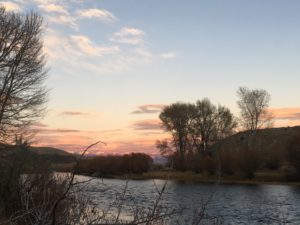Even from a distance of one hundred and fifty yards, it was evident the bird was large. Off on a shallow side channel away from the main flow, it appeared to be struggling with something unwieldy, lying half-concealed in the water. Several times the bird attempted to lift off, grasping whatever it was between its talons, with no success. From the far bank, concealed by a stand of cottonwoods along the river, came the cry of a second bird.
“That sounds like a bald eagle,” said Caveman. “The one downriver looks like a golden.”

We floated closer, silently hoping to get a better view of what it was the golden was struggling with. Upon our approach, the bird lifted off the water in a flurry of enormous wings, retreating to the outstretched limb of a bare cottonwood, where it alighted next to a second golden, stark against a flawless Montana sky.
From upstream came another cry, and we looked to see a bald eagle perched on the branch of another cottonwood fifty yards distant, facing the two goldens. More trash talking ensued between the two adversaries, squaring off like a couple of Wild West gunslingers at the opposite ends of Main Street, high noon.
The stand off continued for another thirty seconds before the bald, followed a second later by the golden, swooped down off their respective branches, the distance between them closing in a matter of seconds. It seemed the extra time the bald eagle had to prepare gave it the advantage of height and position in the initial contact. Suddenly, all was a whirl of extended talons, contorting bodies and flapping wings as they engaged in aerial combat. As quickly as it began, they disengaged, the golden swooping low then turning and retreating to its branch while the bald uttered a cry of apparent victory and flew off toward the spoils of war. A lone magpie, having taken advantage of the larger birds’ distraction, and pecking at whatever it was in the water, beat a hasty retreat as the bald settled on its prize.
“Do you want eddy out and go see what it was they were fighting over?”
I shook my head. “No, let them be.”
For the rest of the afternoon, as we cast dry flies to grassy banks and languid bubble lines, drifting toward a take out where my truck awaited with coolers of food and beer and warm sleeping bags, I thought of the struggle for survival we had just been privileged to witness, one of thousands of such dramas playing out daily in the natural world around us, and of the ties that bind us all, wings, fins, two legs or four.

